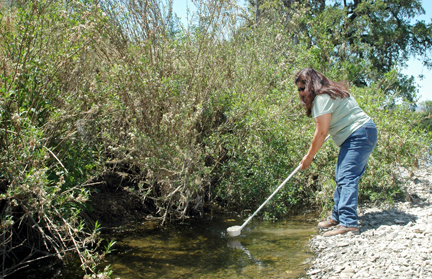
As grant ends, SBC looks at new funding options
As San Benito County finished its first year of a mosquito
abatement program meant to combat the bugs that carry West Nile
Virus, the Division of Environmental Health presented funding
options to the Board of Supervisors July 5 that include creating a
mosquito abatement district or inter-agency funding.
As grant ends, SBC looks at new funding options
HOLLISTER – As San Benito County finished its first year of a mosquito abatement program meant to combat the bugs that carry West Nile Virus, the Division of Environmental Health presented funding options to the Board of Supervisors July 5 that include creating a mosquito abatement district or inter-agency funding.
On June 30, time and funding ran out on a one-time grant of $185,000 received by the Agricultural Commissioner and the Division of Environmental Health for mosquito abatement from the State Department of Health. The county also allocated $80,000 for the 2005-2006 fiscal year.
“I don’t see this issue going away since we have global diseases now,” Supervisor Reb Monaco said. “We need to look at a long-term consistent model.”
Mosquito abatement generally includes eradicating mosquito pools, or larvae, surveillance of adult mosquito populations and education of the public about how to avoid or deter mosquitoes in their communities. In the last several years, the focus has been on West Nile Virus, but mosquitoes can cause other health problems including encephalitis, a swelling of the brain.
While West Nile infections of mosquitoes and birds in San Benito County have been few, Santa Clara County, which has an established mosquito abatement district, has had more reports of the infection. This week, a West Nile positive bird was collected in Santa Clara County.
“Being a biologist, I know mosquitoes don’t pay attention to county borders or whatever,” Monaco said.
Of the two options presented to continue mosquito abatement, inter-agency funding seemed the less desirable of the two to the supervisors. That option would require the cities of Hollister, San Juan Bautista and the county to allocate funds each year from their general funds of at least $65,000.
“Any cost sharing would be derived from less stable general funds,” said Matt Fiore, a registered environmental health specialist, during a presentation to the Board.
A mosquito abatement district would be paid for by a parcel assessment of property within in the district, offering stable funds once it is established.
However, starting a district can take a year or longer and it requires start up money that would need to come from the county or local cities.
“The up front cost of $60,000-$80,000 would be recovered in the first year, so there is no out of pocket cost,” Fiore said.
The costs would include surveys and feasibility studies, preparation of an engineer’s report, a vote by property owners and consultant services.
Monaco and Marcus expressed support of a mosquito abatement district, though Monaco had several questions he asked the West Nile Task Force to research further, including the boundaries of a possible district. Fiore pointed out that most districts do not match the boundaries of counties. Further biological studies would determine the area to be incorporated in the district based on proximity to water, the types of mosquito population and human populations.
“It’s important that we move in that direction. When will it end?” Supervisor Don Marcus said, of West Nile Virus. “State funding ends but it’s still going to be here. Mosquitoes are still going to be here.”
The Board directed the West Nile Task Force to engage a consulting firm that will help with the upstart and provide more information on possible district boundaries at the July 25 meeting. The task force will talk to SGI Group, a Fairfield-based consulting firm that has worked with many other counties on starting up vector districts.
Monaco pointed, as stated in the report provided to the supervisors by the Health and Human Services Agency, that 53 of 58 counties in California have mosquito abatement districts.
“We wouldn’t be reinventing the wheel here,” he said.









